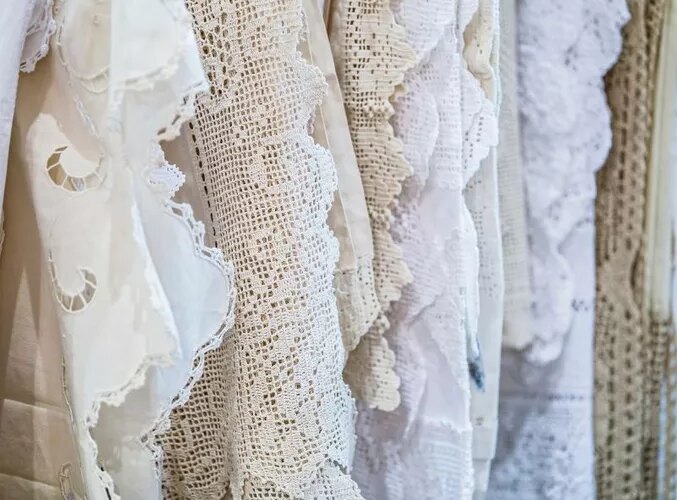People associate lace with luxury, elegance, and femininity. The intricately woven fabric is popular in the fashion industry. Let’s learn more about lace.
1. What is lace fabric?
Lace fabric, also referred to as lace, is a textile that is constructed by interlinking numerous threads through looping, braiding, or twisting techniques, resulting in the creation of multiple holes and gaps on its surface. This intricate fabric is commonly crafted from materials such as cotton, silk, and synthetic silk. Lace fabrics are typically available in white or various other colors, and they exhibit a wide array of decorative patterns, enhancing their visual appeal.
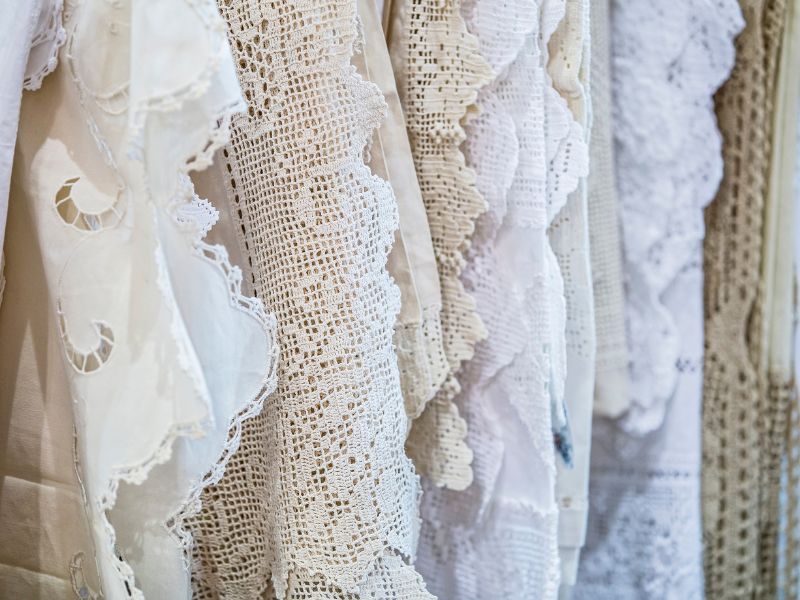
Lace fabric is a delicate and intricate textile that is commonly used in the fashion industry. It is characterized by its openwork pattern, which is created by looping and intertwining threads or delicate fibers. Lace fabric can be made from a variety of materials such as cotton, silk, or synthetic fibers.
In terms of its applications in fashion, lace fabric is highly versatile and can be used in various ways. It is often used to add a touch of elegance and femininity to garments. Lace can be found in dresses, blouses, skirts, and even lingerie, giving them a romantic and delicate aesthetic.
In addition to clothing, lace fabric is also used in accessories such as hats, scarves, and gloves, adding a decorative element to these items. It can also be used as a trim or embellishment on bags, shoes, or even jewelry.
Lace fabric is not only limited to clothing and accessories, but it is also used in home decor. It can be found in curtains, tablecloths, beddings, and even upholstery, bringing a sense of luxury and sophistication to interior spaces.
Overall, lace fabric is cherished for its intricate design, delicate texture, and timeless beauty. Its applications in fashion are vast, making it a popular choice for both designers and consumers who appreciate its elegance and versatility.
The history and evolution of lace fabric.
Lace fabric emerged during the late 15th century and was initially meticulously crafted using luxurious materials like linen, silk, gold, or silver. As a result, this exquisite fabric was exclusively reserved for the upper class and nobility.
During the early 17th century, there was significant economic growth in Europe which led to advancements in lace making techniques. This resulted in the production of high-quality lace in various countries including Spain, England, France, and Belgium. As a result, lace became increasingly popular and was widely used in the clothing of both the upper class and the middle class.
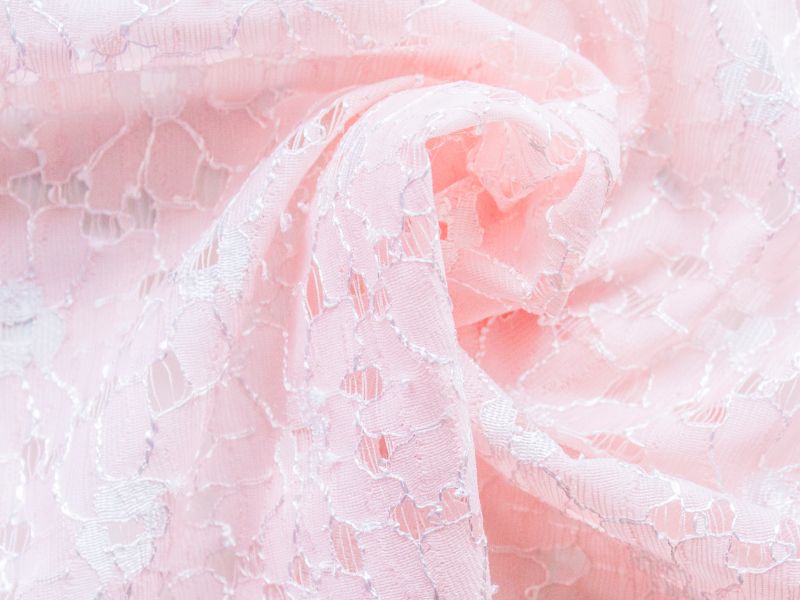
The origin and development of lace fabric can be traced back to ancient civilizations. Lace-making techniques have evolved and been perfected over centuries, resulting in the intricate and delicate lace fabrics we see today.
Lace can be made using various materials such as silk, cotton, or synthetic fibers. The process of creating lace involves intricate handwork or machine techniques, where threads are interwoven or looped together to form intricate patterns and designs.
Historically, lace was a symbol of wealth and status, reserved for the noble and wealthy. It was painstakingly crafted by skilled artisans, often taking months to complete a single piece. Lace was used in clothing, accessories, and even home décor, adding an element of elegance and sophistication.
Throughout history, different regions and cultures have created their own unique lace styles and techniques. For example, Belgium and France are renowned for their delicate and intricate needle lace, while Italy is famous for its exquisite bobbin lace. England’s Nottingham lace is known for its extensive use in wedding gowns and formal attire.
With the advent of industrialization, lace production became more accessible to the masses. Machines were developed to replicate the intricate handcrafted designs, making lace more affordable and available to a wider range of people. This led to lace becoming a popular choice for wedding dresses, lingerie, and everyday clothing items.
Today, lace continues to be a beloved fabric in the fashion industry. Designers incorporate lace into their collections, creating garments and accessories that showcase the beauty and timeless charm of this fabric. Lace is also used in home decor, adding an elegant touch to curtains, tablecloths, and bedding.
The origin and development of lace fabric is a testament to the creativity and skill of artisans throughout history. It is a fabric that has stood the test of time and continues to captivate with its intricate patterns and delicate beauty.
In the 19th century, significant advancements in textile production occurred with the emergence of poly and nylon fabrics, along with the integration of technological innovations and machinery. These developments had a profound impact on the cost of manufacturing lace, leading to a significant reduction in its price. This transformative shift made lace more accessible and affordable to a larger portion of the population.
During the late 19th century, lace fabrics were introduced to Asia, specifically in China, marking the beginning of their widespread usage across different parts of the world.
In the present day, lace has undergone significant advancements and continues to evolve through constant innovation in design, weaving techniques, and applications. It has come a long way from traditional hand-embroidered lace to include modern variations such as crocheted lace and computer-generated lace. The market is flooded with a wide array of lace styles and colors, catering to the diverse needs of consumers.
Lace is no longer limited to high-end clothing; it has found its place in popular fashion designs, accessories, home furnishings, and even unique works of art. This versatile material is widely used in the fashion industry to add a touch of elegance and sophistication to garments and accessories. Additionally, lace is employed in the creation of stylish home decor items, such as curtains and tablecloths, which enhance the aesthetic appeal of living spaces.
Moreover, the artistic possibilities of lace have expanded, with this delicate fabric being utilized in the creation of unique works of art. Artists and craftsmen explore lace as a medium to express their creativity and produce intricate and visually stunning pieces.
Overall, lace has embraced innovation over time, ranging from traditional hand-embroidered forms to more contemporary versions. Its applications have expanded beyond clothing to encompass various industries, meeting the diverse demands of consumers and making lace an integral part of modern design and aesthetics.
Today, lace fabrics that are trending include various popular types.
3.1. Needle Lace
Needle lace is a type of lace that is intricately crafted by skilled artisans using a single needle and thread. It exhibits a fragile and delicate beauty, showcasing artistic floral or geometric patterns. The unique advantage of needle lace lies in its ability to bring sophistication, individuality, and diversity to cater to various preferences and requirements. Moreover, this fabric is extensively utilized in the creation of luxurious garments, elegant accessories, and distinctive interior decorations.
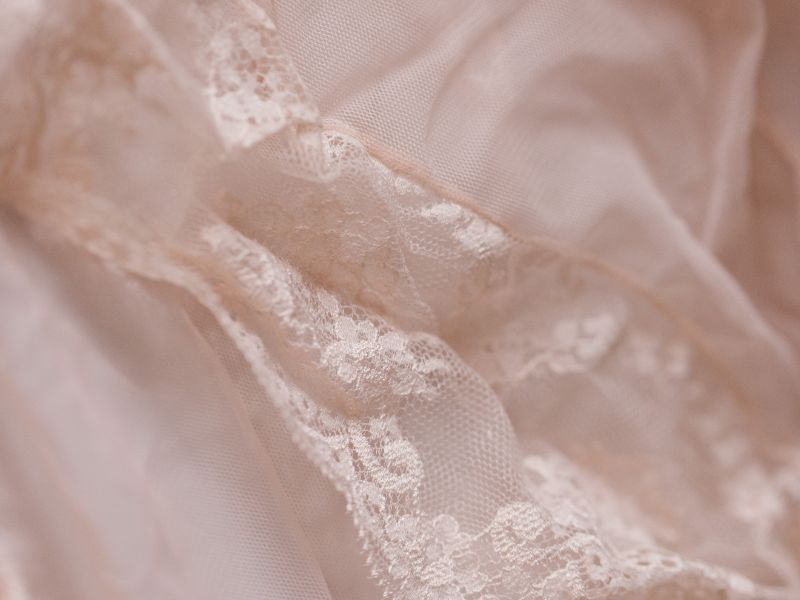
Lace is a widely sought-after textile known for its intricate and exquisite beauty. Its delicate nature adds an elegant touch to any garment or decor.
3.2. Bobbin Lace
Roll lace is a type of lace that is considered to be of high-end and increased popularity compared to needle lace. This exquisite lace is crafted using a unique technique that involves braiding and twisting yarns, resulting in a luxurious and sophisticated aesthetic. The distinguishing feature of roll lace lies in its ability to produce top-notch products using premium materials like silk, cotton, or wool, ensuring both durability and softness. Furthermore, the patterns found in roll lace are incredibly diverse, ranging from elegant floral designs and intricate motifs to stylish modern patterns.
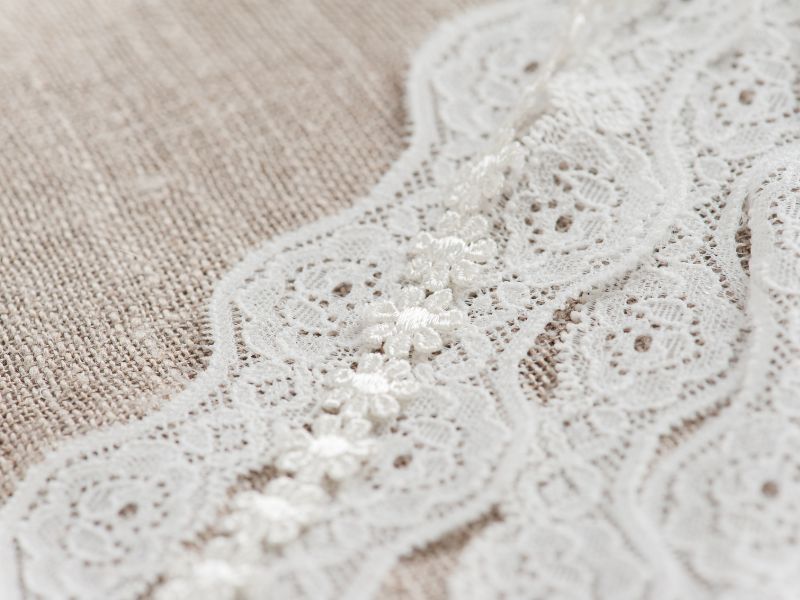
The process of creating roll lace involves intricate techniques of braiding and twisting. These techniques require careful maneuvering and precision to achieve the desired intricate patterns and designs.
3.3. Cutwork Lace
Embroidered lace is a form of lace that is meticulously crafted either by hand embroidery or machine embroidery on a fine layer of fabric. The embroidery process involves creating intricate patterns that result in various gaps or “holes” in different shapes within the lace. The end product is a lace that exudes a delicate and opulent aesthetic. This exquisite type of lace finds extensive application in the fashion industry, particularly in the creation of bridal gowns and other embellished accessories.
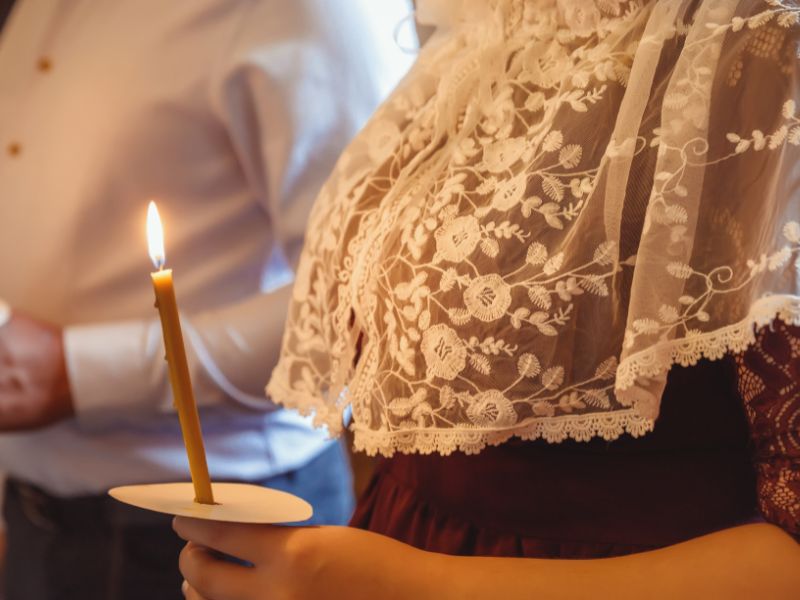
The embroidered lace is exquisitely delicate and possesses a captivating charm.
3.4. Tape Lace
Ribbon lace is a unique kind of lace that can be intricately crafted either by hand or by machine, resulting in long, slender, and delicate strips of lace. This particular lace possesses a graceful and delicate beauty, and it finds extensive application in various domains. In the realm of fashion, ribbon lace is highly sought after for embellishing dresses, adorning collars and sleeves, as well as creating accessories like bows, hairpins, and earrings. Its versatility extends to interior decoration as well, where it is commonly utilized in making tablecloths, curtains, and pillows.
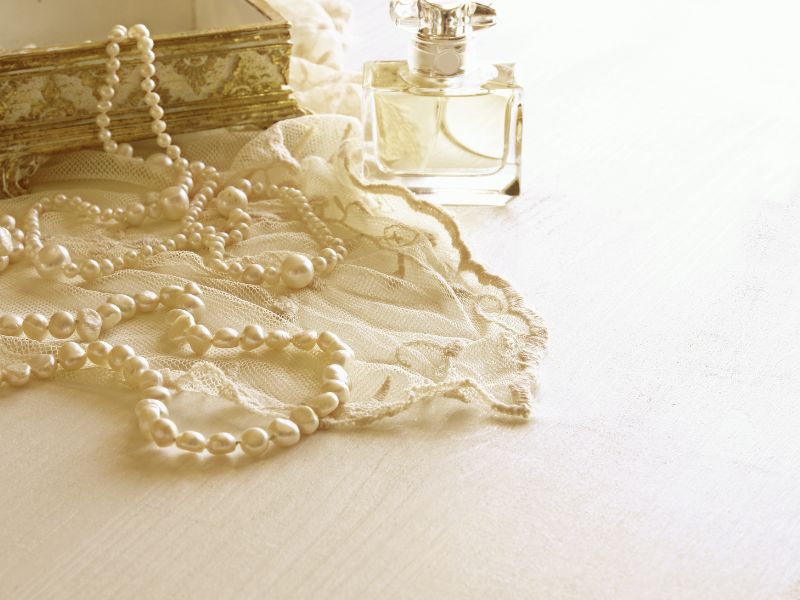
Ribbon lace is a versatile material that is extensively used in various industries, including fashion, interior design, and accessories. It is utilized for its aesthetic appeal and functionality. Ribbon lace adds a delicate and elegant touch to clothing, home decor items, and different types of accessories. Its intricate patterns and designs make it a popular choice among designers and consumers alike. From embellishments on garments to trimmings on curtains, ribbon lace offers endless possibilities for creativity and style. Its versatility and wide range of applications make it a sought-after material in the world of fashion, interiors, and accessories.
3.5. Knotted Lace
Knotted Lace is a distinctive and exquisite form of lace that is meticulously crafted by hand using various knotting techniques. This type of lace possesses a charming rustic beauty, yet it is equally sophisticated and visually appealing. The defining characteristic of knotted lace lies in its handmade nature, which demands the utmost precision and finesse from the artisan. Additionally, knotted lace boasts an array of diverse and intricate patterns, resulting in the creation of one-of-a-kind and impressive products that can be utilized for a multitude of purposes.
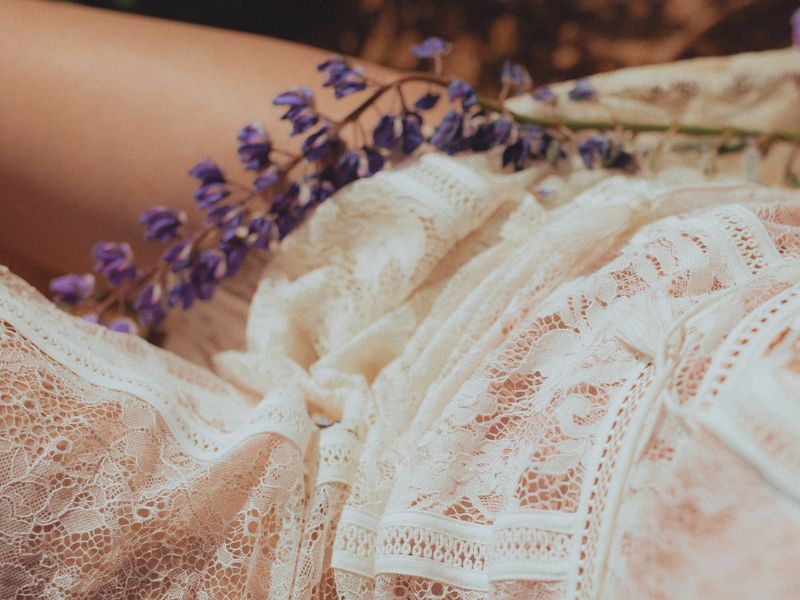
Knotted lace is a type of intricate and delicate craftsmanship that exudes elegance and draws attention with its gentle and captivating beauty.
3.6. Crochet Lace
Crochet Lace is a form of lace that is meticulously crafted using the manual crochet technique. Skilled artisans utilize fine threads to intricately crochet them together, resulting in exquisite and refined lace artworks that are truly one-of-a-kind.
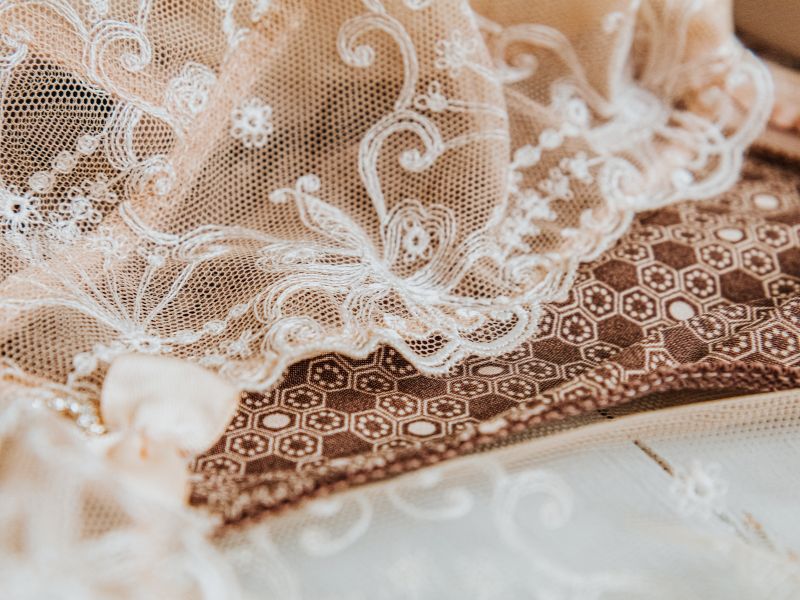
If you are interested in learning about crochet, there are many resources available to help you explore this craft. Crochet is a technique for creating fabric by using a crochet hook and yarn to interlock loops. It allows you to create a wide variety of items such as blankets, scarves, hats, and even intricate lace designs.
To begin your crochet journey, you can start by understanding the basic stitches and techniques. There are several different stitches in crochet, including the single crochet, double crochet, and half-double crochet. Each stitch creates a different texture and look in your projects.
Furthermore, there are countless online tutorials, videos, and books that provide step-by-step instructions and patterns for beginners. You can find these resources on websites, social media platforms, and even in local libraries or craft stores.
It is also recommended to invest in basic crochet supplies such as different sizes of crochet hooks, a variety of yarns in different colors and textures, and stitch markers. These tools will enable you to experiment and create unique designs.
Practicing regularly is essential to improve your crochet skills. Start with small projects and gradually move on to more complex ones as you gain confidence and experience. Joining crochet communities, either online or in person, can also be beneficial as you can connect with fellow crochet enthusiasts, exchange ideas, and seek guidance or inspiration.
Additionally, learning about the different types of crochet patterns and techniques, such as amigurumi (crocheted stuffed animals) or filet crochet (creating images with open spaces), can expand your creativity and broaden your crochet abilities.
In summary, if you are intrigued by crochet, take the time to explore this versatile craft. With the help of various resources, practice, and patience, you can develop your skills and create beautiful and intricate crochet pieces.
Pros and cons of lace fabric.
4.1. Advantages of lace fabric
Lace fabric has a well-established reputation as a representation of opulence, sophistication, and femininity. Renowned for its intricate patterns and delicate structure, lace never fails to bestow upon its wearer an aura of graceful beauty, captivating the attention of all who lay eyes upon it. The numerous advantages offered by this fabric include its exceptional qualities such as:
- Cool and light: Lace fabric has a structure with many small spaces, helping the wearer feel comfortable and pleasant, especially on hot, sultry days.
- Luxurious and charming: With glossy material combined with delicate patterns to create a unique beauty, attracting all eyes. This is also the reason why lace fabric is used to design luxurious dresses, evening gowns, gorgeous wedding dresses or sexy, seductive lingerie.
- Diversity and abundance: Lace fabric comes in many types with different materials, colors and patterns, meeting all user preferences and needs.
- Easy to coordinate: Lace fabric is designed to create many luxurious and elegant outfits that can be mixed & matched with many different items to create the perfect look.
- Wide applicantion: Not only is lace used to design luxurious and perfect outfits, it is also used for many designs related to fields such as interior design, fashion accessories, and handmade items.
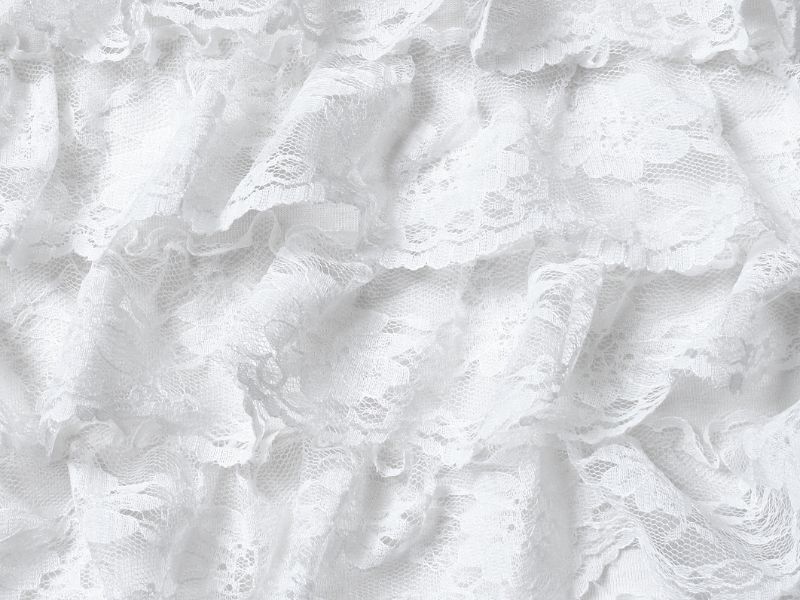
There are several advantages to using lace fabric. Firstly, lace fabric is known for its delicate and intricate design, which adds a touch of elegance and sophistication to any garment or project. The fine threads and patterns create a visually appealing and feminine aesthetic.
Additionally, lace fabric is lightweight and breathable, making it comfortable to wear, especially in warmer climates or during hot seasons. The open-weave structure allows air to pass through, preventing the fabric from feeling heavy or suffocating on the skin.
Moreover, lace fabric offers versatility in terms of styling. It can be used as an accent or overlay to enhance the overall appearance of a dress, skirt, or blouse. It can also be layered with other fabrics to create depth and texture.
Furthermore, lace fabric is durable and has a long lifespan when properly cared for. Many lace fabrics are made with high-quality materials, such as silk or cotton, ensuring their longevity. This makes lace fabric a worthwhile investment as it can be used and enjoyed for years to come.
Lastly, lace fabric is easily customizable. It can be dyed in various colors or embellished with beads, sequins, or embroidery to suit individual preferences and design requirements. This allows for endless creative possibilities and the ability to personalize garments or home decor items.
In conclusion, the advantages of lace fabric include its elegant design, lightweight and breathable nature, versatility in styling, durability, and customization options. These qualities make lace fabric a popular choice for a wide range of fashion and design projects.
Due to its remarkable advantages, lace fabric is undoubtedly the ultimate preference for individuals who desire an opulent, alluring, and refined aesthetic.
Drawbacks of lace fabric include its delicate nature, susceptibility to snagging, and potential for fraying or tearing easily.
In addition to the remarkable benefits of lace fabric, there are also a few drawbacks associated with this type of fabric.
- Fragile and easily torn: Lace fabric is quite fragile and can easily tear if not stored carefully. When washing or drying, be careful to avoid getting caught on sharp objects or strong friction.
- High price: Compared with normal fabrics, lace fabrics are often more expensive due to the complicated production process, some types require manual processing and high techniques.
- Difficult to wash: This is a difficult fabric to clean, need to be gently washed or hand washed, dry cleaned carefully. If washed incorrectly, lace clothes can be damaged.
- Need lining: Woolen clothes are quite fragile and transparent, so lace fabrics need to be lined when used to ensure privacy and elegance.
- Easy to collect dust and dirt: With its patterned and holey structure, lace fabric is more prone to dirt than other fabrics. Regular washing and ironing is needed to keep lace fabric clean and beautiful.

Lace fabric is a highly favored type of fabric due to its delicate and intricate design. It is characterized by its openwork patterns and is commonly used in various applications, including clothing, home decor, and accessories. However, despite its popularity, lace fabric does come with a few limitations that should be considered.
One limitation of lace fabric is its fragility. The delicate nature of lace makes it prone to tearing or snagging, especially if handled roughly or exposed to sharp objects. Careful handling is required to preserve the fabric’s beautiful design and prevent any damage.
Another limitation of lace fabric is its limited stretchability and flexibility. Compared to other types of fabrics, lace has less give and may not provide as much comfort or ease of movement. This can be a consideration when using lace for garments or other items that require flexibility and comfort.
Additionally, lace fabric is often not as durable as other types of fabrics. Due to the intricate patterns and delicate threads used in its construction, lace may not withstand heavy wear and tear over time. It may require more frequent care and maintenance to ensure its longevity.
Lastly, lace fabric can be more challenging to work with compared to other fabrics. Its intricate designs and delicate threads can make cutting and sewing more intricate and time-consuming. Extra care must be taken to ensure clean cuts and secure stitching to maintain the fabric’s integrity.
Despite these limitations, lace fabric remains highly sought after for its elegance and timeless appeal. With proper care and consideration for its delicate nature, lace can be a stunning addition to various fashion and design projects.
5. Applications of lace fabric
Lace fabric is highly regarded for its representation of elegance and charm. It is widely sought after and considered the ultimate selection for various fashion designs, lingerie, and interior decoration purposes.
5.1. Application in fashion
Lace fabric has been revered for its exquisite, refined, and captivating beauty for centuries. Its distinct qualities make it the perfect choice for fashion designers, as it effortlessly creates stunning dresses, captivating outfits, and enhances the grandeur of a bride on her special day.
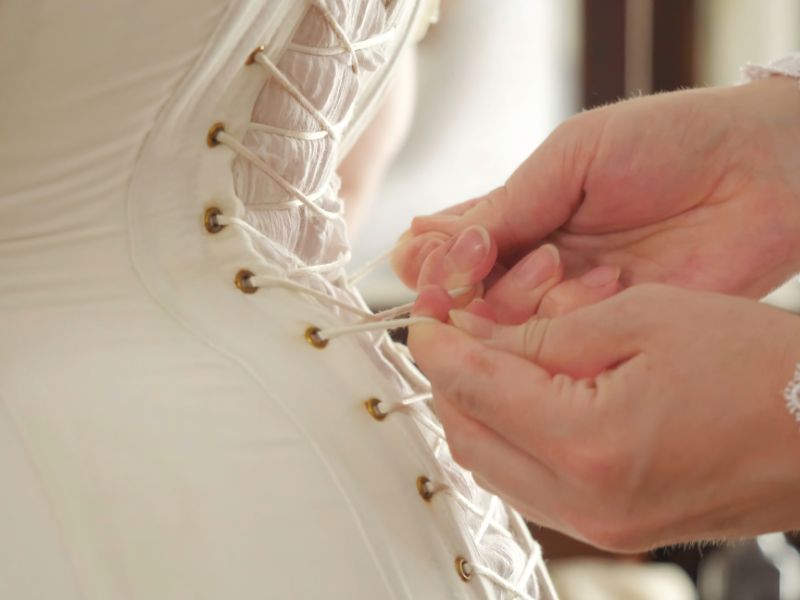
Lace fabric, characterized by its delicate and intricate patterns, is frequently employed in the creation of breathtaking wedding dresses. The ethereal quality of this fabric adds elegance and sophistication to the overall design of the bridal gowns, making them truly stunning and memorable. With its timeless appeal, lace fabric continues to be a popular choice among brides who desire a touch of romance and femininity on their special day.
In addition to being used for bridal ao dai, lace fabric is frequently utilized in the production of underwear and seductive sleepwear. This is due to its exceptional sweat absorption and high breathability, as well as its softness, comfort, and sophisticated appeal for women, creating a sexy and alluring aesthetic.
5.2. Interior applications
In the present day, the use of lace fabric has expanded beyond the realm of fashion and has found its way into the world of interior decoration. This delicate and intricate material is now creatively incorporated into various elements of home decor, including curtains, tablecloths, and bedding. By incorporating lace fabric into these items, a sense of luxury and refinement is added to living spaces, creating visually stunning focal points.
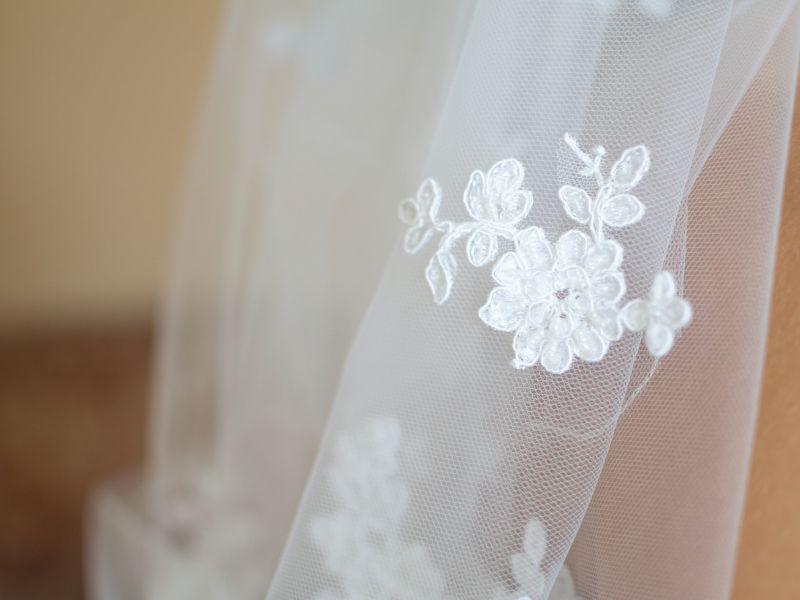
Lace fabric serves as a versatile material that finds applications in interior decoration as well. Its intricate and delicate designs add a touch of elegance and sophistication to various aspects of interior design. Whether it is used as curtains, tablecloths, or upholstery, lace fabric brings a timeless charm to any space. Its airy and translucent nature allows light to filter through, creating a soft and romantic ambiance. Moreover, lace fabric can also be used to craft beautiful decorative elements such as lace trims, doilies, or embellishments for cushions or pillows, adding a unique and intricate touch to the overall decor.
Experienced in selecting lace fabric.
6.1. Seasonal selection
The temperature plays a crucial role in selecting the right lace fabric to ensure maximum comfort and pleasant experience. During the summer season, it is recommended to opt for lace fabrics that have a moderate thickness, are thin, light, and airy. This choice will provide a comfortable and cool sensation while also offering adequate protection for the body. On the other hand, during the winter months, it is advised to prioritize lace fabrics that are thicker and have multiple layers of lining. These fabrics will help in keeping the body warm in colder temperatures.
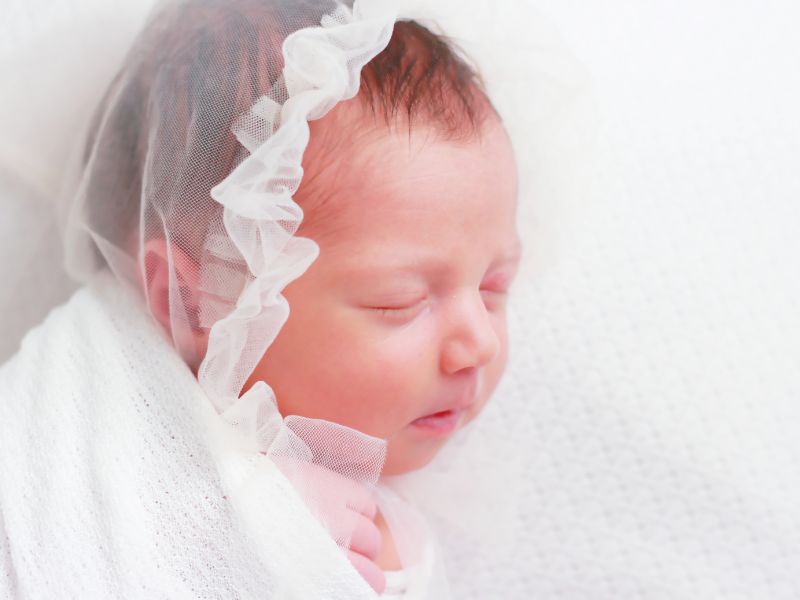
During the summer season, it is recommended to opt for lightweight lace fabric that is both thin and breathable. This type of fabric allows air to flow through, keeping you cool and comfortable in warm weather.
6.2. Select by color
When selecting lace fabric, it is advisable to prioritize lace patterns in white or bright, gentle colors such as pastels. This color scheme creates a cool and youthful feeling. However, during the winter season, it is recommended to opt for dark tones like red, orange, navy blue, or black. These colors can enhance the luxurious and warm appearance of the lace fabric.

When choosing fabrics for an elegant look, it is recommended to prioritize light-colored lace fabrics. These fabrics have a delicate and sophisticated appearance that adds a touch of elegance to any garment or design. The light color of the lace enhances the graceful and ethereal qualities it possesses. By choosing light-colored lace fabrics, you can achieve a refined and classy aesthetic that exudes elegance.
Select based on your body’s shape.
When selecting clothing made of lace, it is important to consider your body shape in order to achieve a balanced and harmonious look while also concealing any imperfections. Those with a slim physique should opt for clothing made of thicker lace to create the illusion of fullness and enhance overall body balance.
For individuals with a round body shape, it is recommended to prioritize thin and light lace fabrics. Additionally, selecting simple patterns and opting for designs that emphasize the waist or hem can help subtly accentuate the curves of the body. On the other hand, for those with an unbalanced body shape, choosing thin lace fabrics and dark colors can effectively conceal any flaws while creating a slim, graceful, and elegant effect.
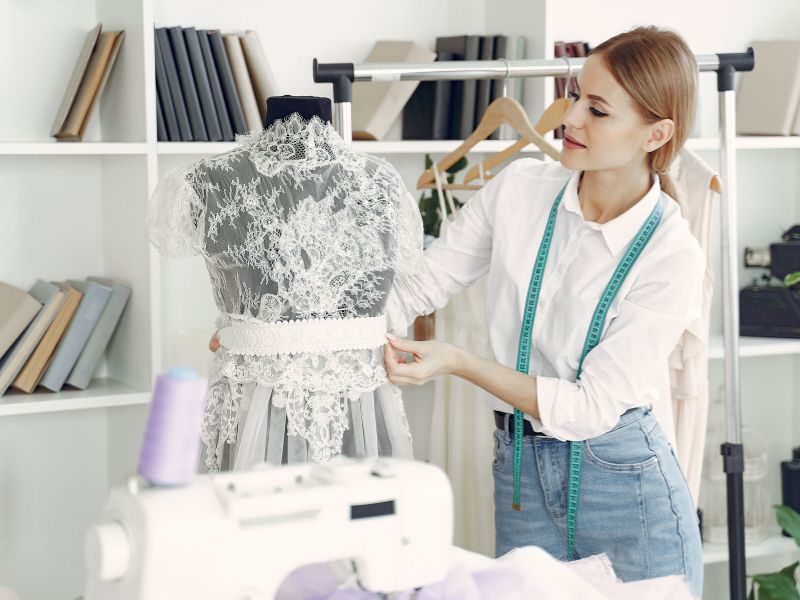
When selecting lace clothing, it is important to consider your body shape. Different body shapes require different styles of lace clothing to flatter and enhance your figure. By choosing lace clothes that suit your body shape, you can ensure that you look stylish and confident.
What are the steps to clean and maintain lace fabric?
Lace fabric is renowned for its delicate and opulent beauty, however, it requires special attention when it comes to cleaning and maintaining its quality. Here are some detailed tips to ensure that your lace items remain beautiful and resilient for a long time:
1. Hand Wash: To prevent damage, always hand wash lace items instead of using a washing machine. Fill a basin with lukewarm water and add a gentle detergent specifically designed for delicate fabrics.
2. Allow Soaking: Immerse your lace items in the soapy water and gently swish them around. Allow them to soak for around 15-20 minutes to remove dirt and stains.
3. Gentle Agitation: Gently agitate the lace fabric by squeezing it in a gentle motion with your hands. Avoid rubbing or wringing, as this can damage the delicate threads and intricate patterns.
4. Rinse Thoroughly: After removing the lace items from the soapy water, rinse them thoroughly under lukewarm water until all the detergent is removed. Avoid using hot water, as it can weaken the fabric.
5. Pat Dry: Lay a clean towel out and carefully place the lace items on it. Roll up the towel to absorb excess moisture, gently pressing down without twisting or wringing. Unroll the towel and allow the lace items to air-dry on a flat surface away from direct sunlight.
6. Iron with Caution: If needed, iron the lace fabric on the lowest heat setting or using the delicate setting. Place a clean, white cloth between the lace and the iron to avoid direct contact. Iron in gentle, sweeping motions without applying too much pressure.
7. Storage: To preserve the shape and prevent snagging, store lace items separately from other garments. Use acid-free tissue paper to stuff the sleeves and prevent creasing, or fold the lace items neatly and place them in a breathable fabric bag or box.
By following these detailed tips, you can ensure that your lace items retain their exquisite beauty and durability, appearing as good as new for years to come.
- Hand wash preferably with mild soap, avoid wringing and rinsing, avoid wringing or rubbing.
- If machine washing, place lace in a mesh laundry bag to avoid snagging and scratches, and choose the gentlest wash cycle.
- Avoid direct sunlight to limit fading and shrinkage.
- Do not tumble dry lace garments as high temperatures can damage the fabric.
- Avoid hanging lace garments as the weight can stretch the fabric. Instead, fold them neatly and store them in a closet or box.
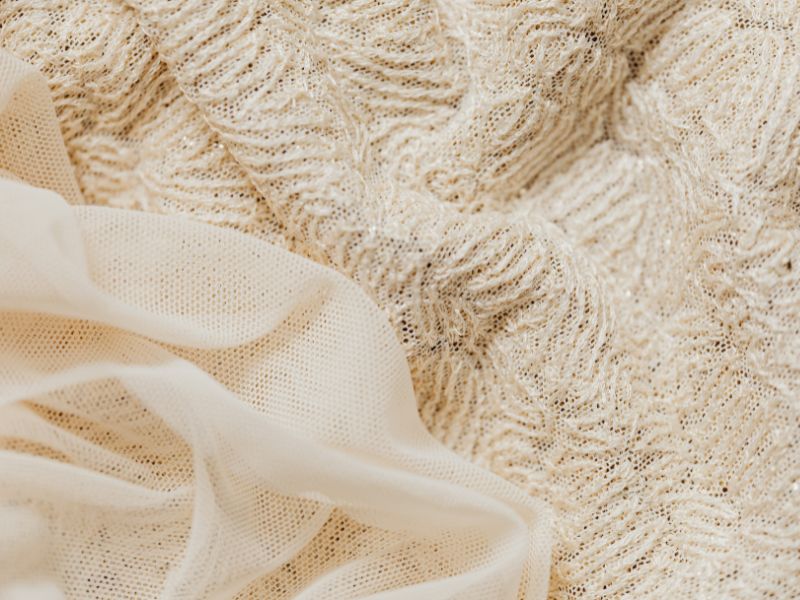
In order to clean and preserve lace fabric, there are several steps and considerations that should be taken into account. First and foremost, lace fabric is delicate and requires gentle handling to prevent any damage.
To begin the cleaning process, it is advisable to check the care label on the lace fabric for any specific instructions provided by the manufacturer. If no specific instructions are available, it is generally recommended to hand wash the lace fabric in lukewarm water with a mild detergent.
Before washing the lace fabric, it is essential to remove any loose dirt or debris by gently shaking it or using a soft brush. This will help avoid any potential damage during the washing process.
When hand washing the lace fabric, it is important to avoid any harsh rubbing or twisting, as this can distort the delicate fabric. Instead, gently immerse the fabric in the soapy water and swish it around to allow the detergent to penetrate and remove any dirt. Let the lace soak for a short period of time, typically around 10-15 minutes.
After soaking, rinse the lace fabric thoroughly under cool running water to remove any soap residue. Avoid wringing or twisting the fabric, as this can cause stretching or tearing.
If necessary, a gentle squeeze can be applied to remove excess water. It is recommended to lay the lace fabric flat on a clean towel and gently press it with another towel to absorb moisture. Hanging lace fabric to dry may cause stretching or distortion, so it’s best to avoid it whenever possible.
In terms of preservation, it is advisable to store lace fabric in a clean, dry, and well-ventilated area. Avoid exposing the lace fabric to direct sunlight, as this can cause fading or discoloration. Additionally, it is important to keep lace fabric away from any sharp objects or rough surfaces that could potentially snag or tear the delicate fabric.
If desired, lace fabric can be stored in acid-free tissue paper or a clean cotton fabric to protect it from dust and potential damage. It may also be beneficial to periodically refold the lace fabric to prevent any creases from becoming permanent.
By following these steps and taking proper care, lace fabric can be effectively cleaned and preserved, ensuring its longevity and beauty for years to come.
The paragraph above provides a comprehensive overview of lace fabric, including its definition and the reasons for its widespread popularity. By understanding what lace fabric is, you can make informed decisions when selecting high-quality, elegant, and suitable outfits. Make sure to stay updated with the Fashion Bandung News section for the latest fashion information.
* “For additional information, please continue reading:”

